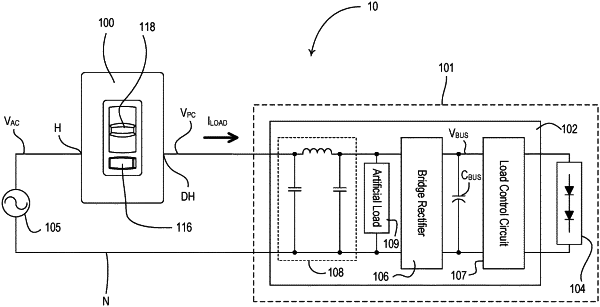| CPC H05B 39/04 (2013.01) [H02M 7/06 (2013.01); H02M 7/155 (2013.01); H02M 7/217 (2013.01); H05B 39/044 (2013.01); H05B 39/048 (2013.01); H05B 41/3924 (2013.01); H05B 45/10 (2020.01); H05B 45/14 (2020.01); H05B 45/37 (2020.01); H05B 47/10 (2020.01); H05B 47/19 (2020.01); H05B 45/315 (2020.01); Y02B 20/30 (2013.01); Y10S 323/905 (2013.01)] | 22 Claims |

|
1. A dimmer switch for controlling an amount of power delivered from an AC power source to a lighting load for controlling an intensity of the lighting load, the dimmer switch comprising:
a triac adapted to be electrically coupled between the AC power source and the lighting load, the triac having first and second main terminals through which current can be conducted to energize the lighting load and a gate terminal through which current can be conducted to render the triac conductive between the first and second main terminals;
a first circuit electrically coupled between the first main terminal of the triac and the gate terminal of the triac to conduct current through the gate terminal of the triac;
a second circuit electrically coupled between the first and second main terminals of the triac to conduct current through the lighting load when the triac is non-conductive; and
a control circuit configured to individually control the first and second circuits to be conductive and non-conductive, the control circuit configured to render the first circuit conductive to conduct a pulse of current through the gate terminal of the triac at a firing time during a present half-cycle of the AC power source to render the triac conductive, the control circuit configured to control the firing time to adjust the intensity of the lighting load;
wherein the control circuit is configured to control the first circuit to allow the first circuit to conduct at least one other pulse of current through the gate terminal of the triac after the firing time during the present half-cycle, the control circuit configured to render the first circuit non-conductive before the end of the present half-cycle to prevent any further pulses of current from being thereafter conducted through the gate terminal of the triac during the present half-cycle, the control circuit further configured to control the second circuit to conduct current through the lighting load after the first circuit is rendered non-conductive.
|